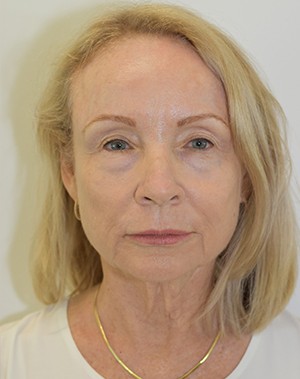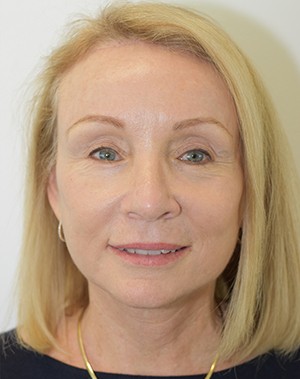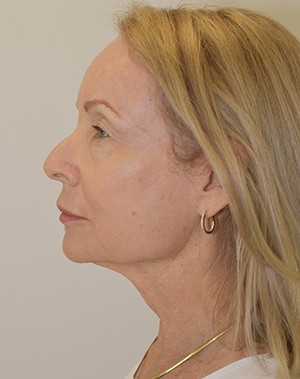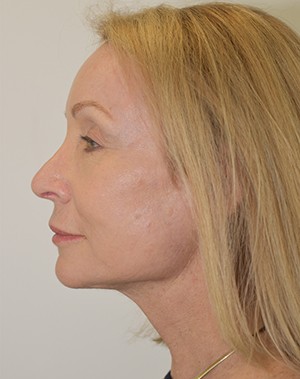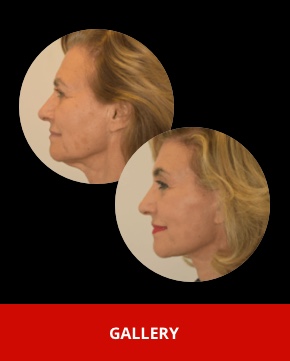Neck Lift Surgery in Sydney
Neck Lift Surgery aims to Restore a More Youthful Look
A neck lift procedure aims to rejuvenate the neck and restore a youthful contour. Droopy skin, fat and muscle in the neck is unfortunately a common problem and is one of the earliest signs of aging for many people. Aging of the face, eyelids and brow often becomes more noticeable some years after the neck. Excess neck tissues can appear quite suddenly. A period of weight gain or loss may precede their development.
Risks of surgery
Cosmetic surgery is a serious decision. Information about the risks of a facelift can be found here.
About Me
As we age, the area under our chins can develop excess fat, sagging skin, muscle or a combination of these. This can give the appearance of weight gain even if you have not actually gained any weight. Sometimes these changes in the neck are referred to as a “turkey neck”.
Results vary from person to person.
Cosmetic surgery is a serious decision. More information about the risks and recovery of each procedure is available on our website.
All surgery performed by Dr Jason Roth (MED0001185485), Otolaryngology head and neck surgeon, Sydney.
Requests to rejuvenate the aging neck are common in both men and women. People are often deeply embarrassed by their ageing neck changes, more so than their face. Friends and colleagues may not be similarly affected and patients’ often describe feelings of self-consciousness.
Often the redundancy of the neck tissues is also seen in the face. In many patients the excess tissue in the neck was originally located up in the face and has fallen slowly over many years below the jawline into the neck. Sun exposure, genetic factors as well as significant changes in weight can accelerate this process.
The best way to rejuvenate the neck is through a neck lift procedure. In this procedure redundant skin, muscle and fat is contoured and re-positioned back where it should have been in earlier years. Sutures are used to suspend the tissue back up around the ears.
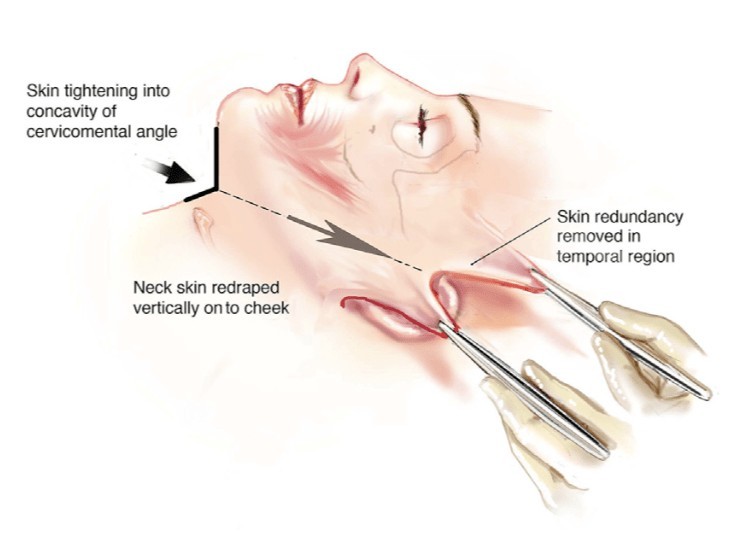
Sometimes a small incision is necessary under the chin where the hanging edges of the platysma muscle are stitched together. Further small incisions hidden around the ear and hairline then allow the neck tissues to be lifted and tightened. The end result is usually a very smooth, tight jawline and neck.
A neck lift can be combined with a facelift to include rejuvenation of the midface and upper face. It can also be performed without including these upper areas. The incisions (scars) for a neck lift are in a very similar location to a facelift so these two procedures are very often performed together. The best necklift results are obtained through a deep plane facelift which includes a necklift.
My Facelift Experience & Training
The best necklift results are obtained when there is full release of the retaining ligaments of the neck and face. Once these are released, the neck and facial tissues can be gently repositioned with no tension leading to natural, long lasting results. Three important retaining ligament groups are the cervical, mandibular and zygomatic.
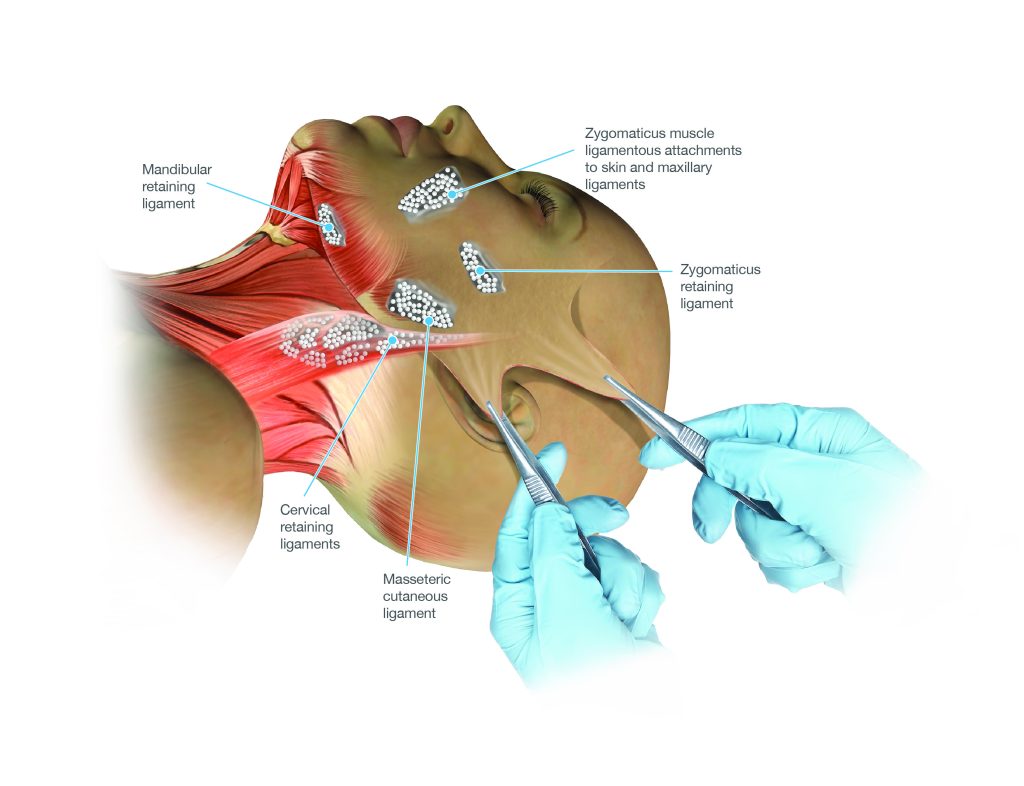
The neck can be a challenging area to treat with more old fashioned surgical techniques such as the “skin only” neck lift and SMAS and MACS facelifts. Injectables (bo-tox, fillers) are often not very helpful in the neck with only very temporary results and best utilised in younger patients with only mild changes of ageing.
Dr Roth is based in Sydney and specialises in the vertical neck lift technique (also known as the vertical platysmal advancement technique) as popularised by Dr Andrew Jacono and Dr Neil Gordon in the USA. The vertical neck lift is an extended deep plane facelift that elevates the skin and SMAS-platysma complex as one unit. It provides beautiful, natural and long-lasting results. Laxity in the neck is dealt with by repositioning tissues to their natural position in the face and jawline.
The vertical neck lift technique does not routinely require midline platysmal surgery (a platysmaplasty) because it counteracts the effects of gravity and ageing by vertical movement of tissues. It is powerful when needed and can tackle even the most challenging necks with good results.
Adjunctive procedures
A number of adjunctive procedures may be necessary at the time of a necklift, depending on patient anatomy. These include removal of excess skin, liposuction, a platysmaplasty, reduction in the size of the digastric muscles, submandibular gland suspension, a chin implant.
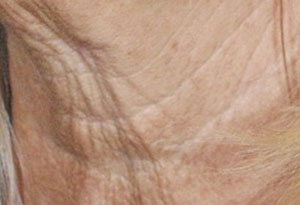 Loose skin removal
Loose skin removal
Loose neck skin tends to wrinkle and sag. The platysma muscle (which is often very prominent in younger patients) tends to thin out leaving redundant overlying skin.
Generally some skin is removed with any necklift procedure apart from in the youngest patients. The actual amount removed varies between patients depending on their anatomy. Skin incisions are designed to optimise loose skin removal and hide scars.
Neck Liposuction
Liposuction removes fat cells through a small suction device. 3 tiny “ports” or cuts in the skin are required to insert the device used to remove the fat. Liposuction only removes fat and does not address excess skin or platysma muscle that may be redundant in the neck. It can be a useful adjunct when recontouring the neck with a necklift procedure. Occasionally it is performed in isolation without other procedures. Neck liposuction needs to be done conservatively to avoid an “overdone” look as well as scarring.
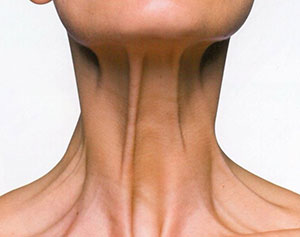 Platysmaplasty
Platysmaplasty
This procedure focuses on the platysma muscle that sits just underneath the skin’s surface at the front of the neck. Over time, this muscle can create significant vertical bands in the neck, adding to an aged appearance.
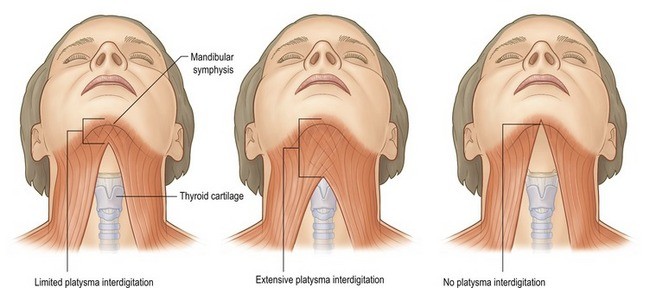
Caption: There are a number of variations in platysma anatomy
When the two edges near the midline hang with a hollow area in between, this can be called a “cobra neck”.
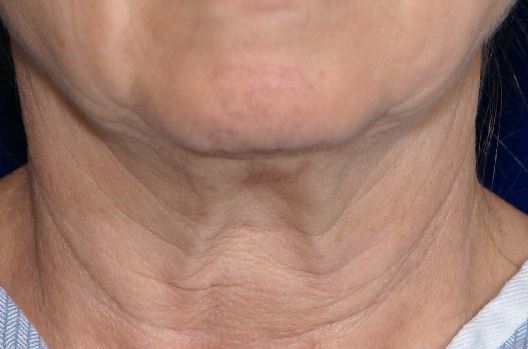
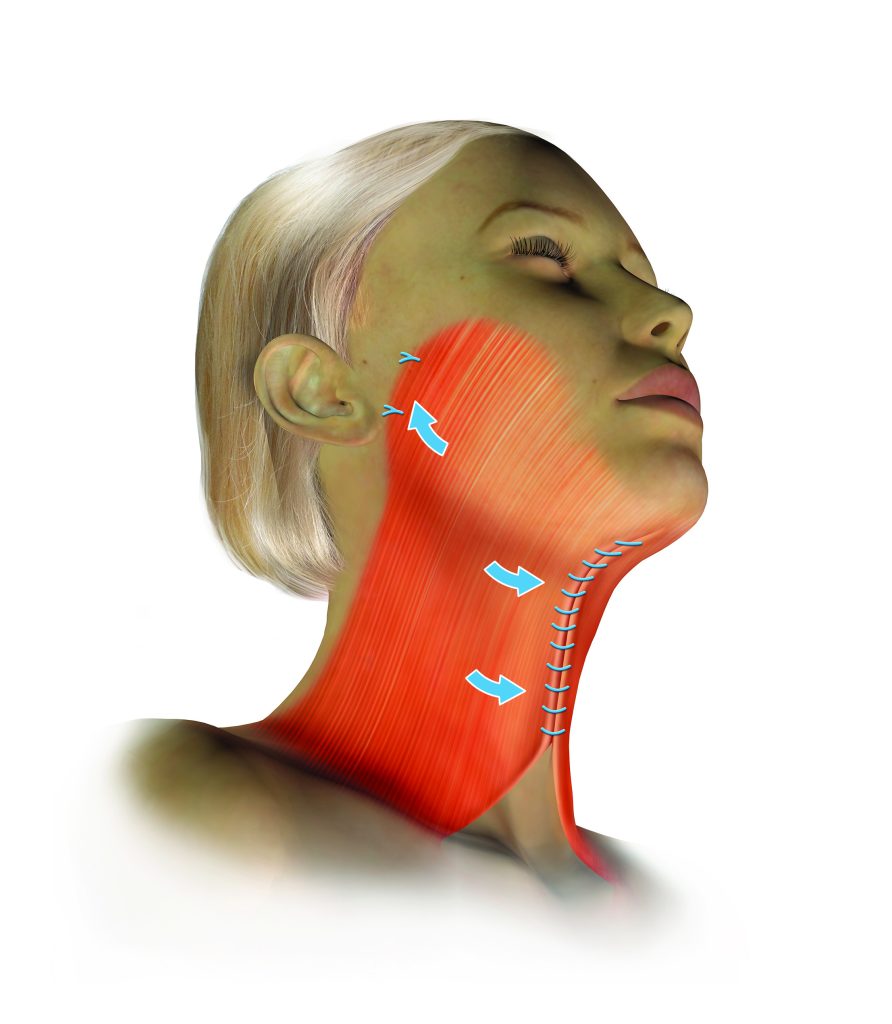
Image depicts the underlying muscle bands being sutured back together.
A platysmaplasty is a surgical procedure that stitches the edges of the muscle together and can create a smoother neck surface. A small incision is made under the neck which allows the two edges to be sutured together in the midline. Once the muscle has been stitched together, it can be lifted by other small incisions located near the ear to eliminate the bands completely.
In the majority of patients who undergo a vertical neck lift which includes a deep plane facelift and necklift, a platysmaplasty is not necessary as the lift procedure will eliminate all redundant platysma. Whether or not a platysmaplasty is needed can be determined at the time of a pre-operation consultation. The essential test is whether the neck redundancy is completely eliminated when the face is lifted from the sides. If that is the case, a platysmaplasty is not needed.
 Digastric muscle reduction
Digastric muscle reduction
Fullness under the chin can often been partially caused by a low hanging belly of the digastric muscle. This is particularly the case in individuals who are born with a hyoid bone that sits low in the neck. The digastric muscle attaches to the hyoid bone. The anterior belly of the digastric muscle can be partially reduced in size to improve the contour of the upper neck.
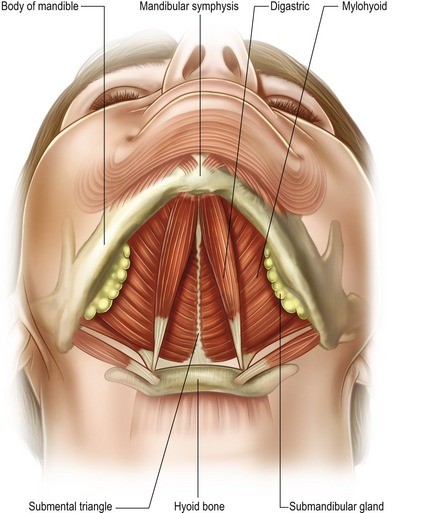
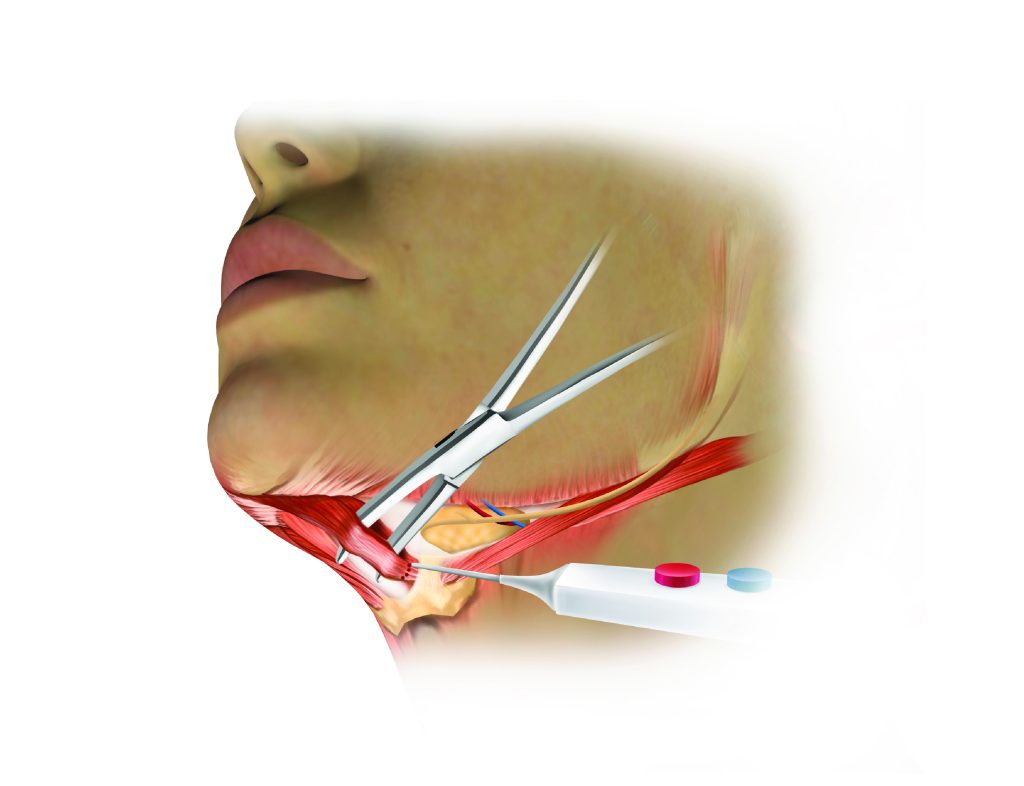
Image depicts the underlying muscle bands being sutured back together.

Image depicts the digastric muscle being partially reduced in size.
Submandibular gland suspension
The submandibular glands tend to droop down into the neck with age. This can lead to a bulge in the upper neck about halfway along the jawline. It is important to support and elevate the submandibular glands as part of a necklift procedure.
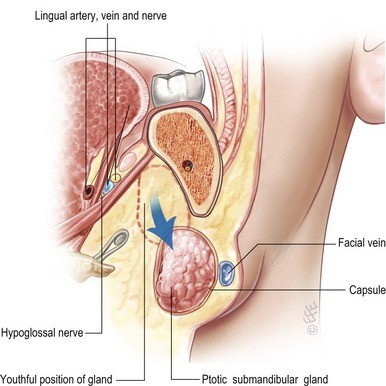
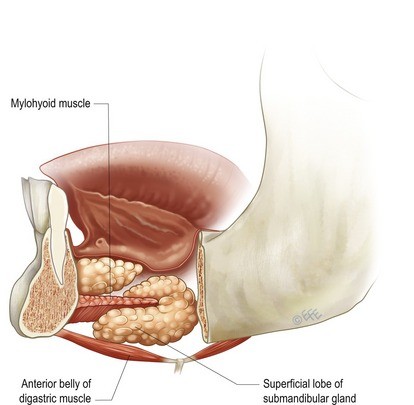
Dr Roth uses a technique whereby the platysma muscle is tightened like a hammock under the submandibular gland to effectively tuck it upwards under the jawline.

Chin implants
A recessed chin can impair a good neck lift result. A chin implant can be inserted at the same time as necklift surgery for a better result if needed.
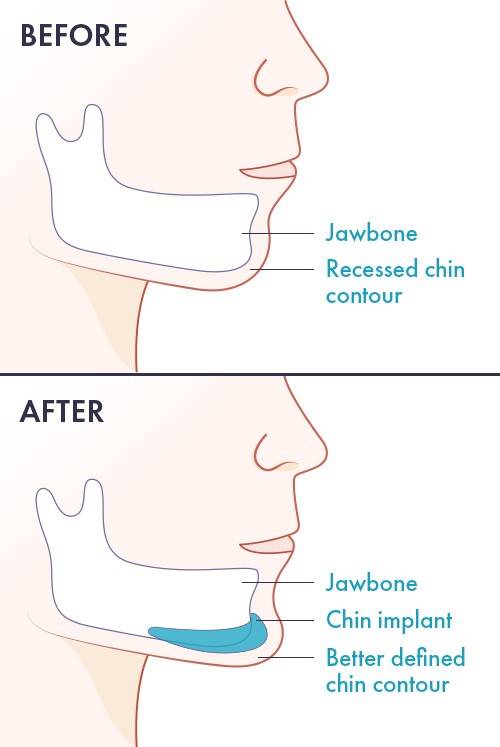
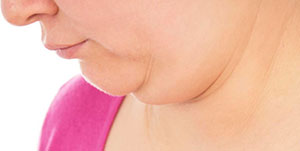 Submental fat removal
Submental fat removal
If prominent, fat under the chin may need to be removed directly. This can be done with scissors or liposuction. The fat can be located over the top of the platysma muscle, between the muscles in the midline or underneath the muscle.
Dr Jason Roth is a Sydney-based Specialist ENT and Head & Neck Surgeon who is trained to perform neck lift and facelift procedures safely and effectively. He has trained with Dr Neil Gordon, one of the leading facelift and neck lift specialists in the United States. He has also been certified with the International Board Certification in Facial Plastic Surgery.
About Dr Jason Roth, MBBS, FRACS

Dr Jason Roth is a Sydney ENT Specialist and Head & Neck Surgeon with Facial Plastic Surgery Fellowship training from Australia, the United States and Europe. He is an expert in Facelift Surgery, Rhinoplasty, Nose and Sinus Surgery.
He consults from his clinic in Dee Why and operates at several private hospitals across Sydney. Importantly, Dr Roth performs more than 50+ face and neck lift operations per year, which makes him one of Sydney’s busiest neck and face lift surgeons. Dr Roth has exposure to a high volume of patients with both common and rare clinical problems, allowing him to develop a depth of expertise. View his full profile here.

